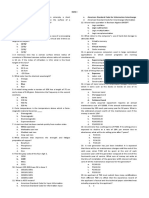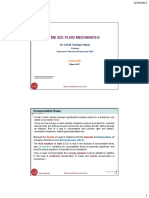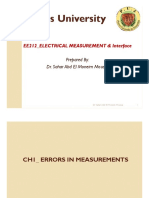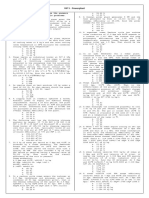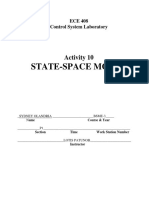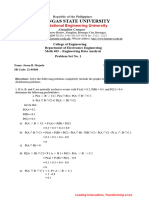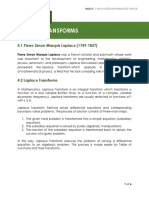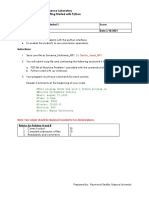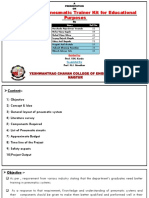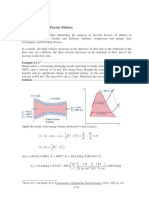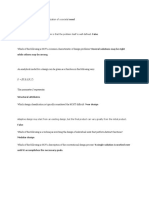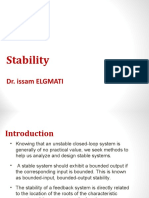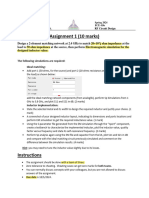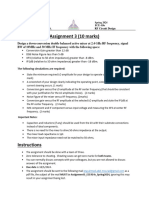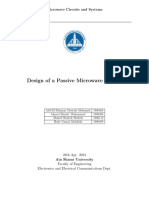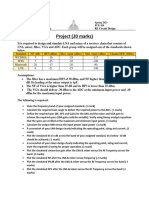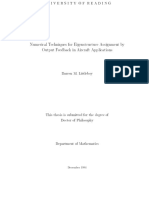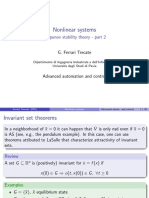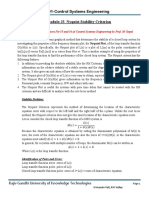Faculty of Engineering
Computer and Systems Engineering Department
CSE 371: Control Engineering
Topic# 5
Stability of Linear Control Systems
Prof. Wahied Gharieb Ali
� TOPICS
• Definitions
• BIBO Stability
• Relative Stability
• Routh-Hurwitz Criterion
• Special Case 1 : Zero first-column Element
• Special Case 2: Zero Row
• Application of Routh’s Criterion
2
� Definitions
The zero-state response (forced response) is due to the
external input only where all initial conditions of the system are
zero
The zero-input response (free response) is due to the initial
conditions only where all the inputs are zero
Since we are dealing with linear systems, then:
The total response = zero-state response + zero-input
response
3
� BIBO stability
Bounded-Input Bounded-Output (BIBO) Stability
With zero initial conditions, the system is said to be BIBO
stable, or simply stable, if its output y(t) is bounded to a
bounded input u(t).
Thus, for BIBO stability, the roots of the characteristic
equation (the poles of G(s)) can not be located in the right-half
s-plane or on the i axis
If a system is not BIBO stable, it is said to be unstable.
4
� Relative Stability
Zero-input and Asymptotic Stability
Zero-input stability refers to the stability of the system driven
by the initial conditions and the input is zero
If the zero-input response y(t), subjects to the finite initial
conditions reaches zero as t approaches infinity, the system is
said to be zero-input stable.
Mathematically, a system is zero-input stable if for any set of
finite initial conditions, there exists a positive number M which
depends on y(k)(t0) such that: y (t ) M 1
y (t ) 0 2
lim
t
5
� Summary of Stability Conditions
Condition Root value (si=i+ji)
Stable i<0
Marginally Stable i=0 (complex roots)
Unstable i>0 for any i
i=0 for multiple order root
5
• Examples: G s is a stable system because all roots are
( s 1)s 2 ( s 3)
in the left half s-plane.
5
G s
• ( s 1)( s 3) is unstable be cause s=1 is positive poles
5(s 4)
G s 2 is marginally s j ( 0)
( s 1)( s 3)
5(s 4)
G s 2
( s 1) 2 ( s 3) is unstable because s j ( 0)
stable. is multiple
6
order.
� Routh-Hurwitz Criterion
7
� Routh-Hurwitz Criterion
8
� Routh-Hurwitz Criterion
9
� Routh-Hurwitz Criterion
; K>0
10
� Routh-Hurwitz Criterion
System of order n:
an s n an 1 s n 1 ... a1 s a0 0
sn an an-2 an-4 ... an 1an 2 an .an 3
b1
Sn-1 an-1 an-3 an-5 ...
an 1
a a an .an 5
Sn-2 b1 b2 b3 ... b2 n 1 n 4
an 1
Sn-2 c1 c2 c3 ... b1an 3 an 1 .b2
c1
. . . . b1
. b a a .b
. c2 1 n 5 n 1 3
b1
s1 . .
s0 x1
11
� Routh-Hurwitz Criterion
Example: (s+1)(s+2)(s+3)(s+4)=0
s4 + 7s3 + 17s2+ 17s + 6 = 0
s4 1 17 6
s3 7 17 0
s2 14.5 6
s1 14.1 0
s0 6
It is seen that all elements of the first column in the table are positive
which implies that there are no sign changes. This means, by Routh’s
criterion that none of the roots of the given equation are with positive real
part (which of course, we know at least for this equation). The system is
stable.
12
� Routh-Hurwitz Criterion
If the first term in a row is zero, before ending the tabulation,
the zero is replaced by a small positive value and the
calculation continues as described below
Example s5 +s4 + 2s3 + 2s2+ 3s + 5 = 0
s5 1 2 3 Test breaks down
When such case occurs, we replace
s4 1 2 5 0 by a very small number
s3 0 -2 0
s2 -2
13
� Routh-Hurwitz Criterion
s5 1 2 3 (>0 as per assumption)
There are two sign changes
s4 1 2 5
and hence two roots of the
s3 -2 equation on the right half s-
plane.
s2 2+2/2/ -2
s1 (-4/+2)/2-2 5 0 Note that the method may
not give correct results if the
s0 5
equation have only imaginary
roots.
14
� Special Case 2: Zero Row
Case 2: When all elements in a particular row become zero
before completing the tabulation.
This happens when there are pairs of roots which are equal in
magnitude but opposite in sign like when there are two roots on
the imaginary axis or when two pairs of roots are
symmetrically placed around the origin in quadruple.
This case indicates :
• There is at least two real roots equal magnitude and
opposite sign
• One or more pairs if imaginary roots
• A pair of symmetric complex roots
15
� Special Case 2: Zero Row
In this special case, we use what is called the Auxiliary
Equation or Auxiliary Polynomial A(s)=0 which is formed
from the coefficients immediately previous to all zero row.
1. Form A(s) = 0
2. dA(s)/ds = 0 (differentiate the A.E with respect to s)
3. Replace the zero row by the coefficients of dA(s)/ds=0
4. Continue the tabulation as usual
Example s5 + 2s4 + 24s3+ 48s2 - 25s-50 = 0
s5 1 24 -25
s4 2 48 -50 Auxiliary Equation A(s) = 2s4 +48s2 -50 = 0
dA(s)/ds=8s3 + 96s=0
s3 0 0 0 All zero row
16
� Special Case 2: Zero Row
s5 1 24 -25
There is one sign change in the
s4 2 48 -50 element in the first column and
s3 8 96
therefore there is one root on the
right half of the s-plane.
s2 24 -50
S1 112.7 0
S0 -50 By solving the auxiliary polynomial equation
s2=1 and s2=-25 s=1 , s= j5
So, the original equation can be factored as :
(s+1)(s-1)(s+j5)(s-j5)(s+2)=0
17
� Limitation of Routh-Hurwitz Criterion
• It gives only information about the absolute stability of
the system. The degree of stability of a stable system can
not be obtained.
• The criterion can be applied only if the characteristic
equation has constant coefficients and can not be applied if
they are not real or contains exponential terms as in the
case of systems with dead time.
18
� Application of the Routh’s Criterion
• Routh criterion can be applied to determine the range of
certain parameters of a system to ensure stability. For example
it is usually to interest to find the range of the open loop gain K
for the closed loop stability.
Example Consider a unity feedback control system with open loop gain :
K
G (s)
s ( s 30)( s 40)
Determine the range of values for the closed loop stability.
The closed-loop transfer function is:
K
G (s) s ( s 30)( s 40) K
GCL ( s ) 3
1 G (s) 1 K s 70s 2 1200s K
s ( s 30)( s 40)
19
� Application of the Routh’s Criterion
The characteristic equation is : s3 + 70s2 +1200s +K = 0
• From necessary conditions K > 0
• From Routh’s table
s3 1 1200
s2 70 K
s1 (84000-K)/70 0
s0 K
• For all elements in the first column to be positive (same sign) K < 84000.
•The range of K for stability is thus 0 < K < 84000
20
� Remember That!
21
